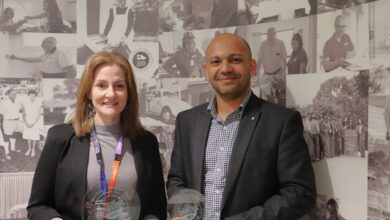All care and more responsibility
Nursing is rapidly evolving due to advances in technology and extended scopes of practice. Linda Belardi talks to some chief nurses who reflect on the changing face of the profession.
From growing roles in private practice and business to Australia’s first family nurse practitioner, nurses are taking on new and extended jobs in the healthcare system.
Reflecting on the future of the profession, Catherine Stoddardt, Western Australia’s Chief Nurse, says we are not too far off from granting registered nurses the right to prescribe medication.
“I look forward to changes in legislation and education preparation that allows for limited prescribing for registered nurses on graduation – similar to that which has existed for some time in the UK and many other countries,” says Stoddardt.
The ACT Chief Nurse, Veronica Croome, agrees that endorsement to prescribe drugs is the natural next step for registered nursing, but like many professional milestones she says it will be a hard-fought victory.
“There will be an enormous amount of opposition from other health professionals that will see that as crossing the boundary that belongs to other health professionals, like doctors and pharmacists. But I think if you have a formulary that is limited to the skills of the nurse, then it’s a safe thing to do.”
Commonwealth Chief Nurse Rosemary Bryant says nurses and midwives are already practising with extended scopes of practice and this will continue to expand to meet the healthcare demands of the community.
In particular, the shift away from hospital-based care to the community will offer a wider scope of practice for nurses. Despite significant growth, the use of nurses in primary health care in Australia remains lower than in other comparable health systems such as the UK and New Zealand.
There are currently more than 27,000 nurses practicing in primary health care, including some 10,000 in general practice, which is Australia’s fastest growing nursing specialty.
Bryant says general practice nurses including registered and enrolled nurses and Aboriginal health workers have a vital role to play in easing the pressure on GPs. The role of the NP in primary health care is also moving forward faster than it is other healthcare environments.
Croome says new opportunities will open up for nurse endoscopists, surgical assistants in the operating theatre and in paramedicine. For the first time, the ACT offered a double degree in nursing and paramedicine, which was significantly oversubscribed.
Stoddart says she is a strong advocate for the introduction of the family nurse practitioner as a critical first port of call for the community. “They will be able to provide their community with care from the cradle to the grave,” she says.
Family health nursing is a recommended strategy of the World Health Organisation. Internationally, family health nurses co-ordinate healthcare, social care housing and education services for vulnerable families. Western Australia has also recently established a nurse practitioner education-led clinic to care for the homeless and vulnerable, with the intention of further expansion.
However, Croome says that despite Australia’s 15-year history with nurse practitioners, attitudinal barriers are still impeding their progress. “We need to be asking the question, “why not?” rather than justifying why. If we can start to normalise the nurse practitioner, we will start to view them as part of the healthcare team rather than something that is still quite different and unique.”
As the boundaries between the professions blur, Stoddardt says nurses will need to be clear about the role of nursing but also professionally generous to other health colleagues.“
Stoddardt, who was named the 2011 Telstra businesswoman of the year for WA, says there is a growing role for nurses to become managers.
“Our nurse managers and executives are becoming much more business oriented – running small to medium business units with large budgets, staff and making time critical decisions that affect vulnerable customers.”
Is technology a double-edged sword?
In the drive for increased specialisation, nursing may have lost sight of the fundamentals of care, warned the ACT chief nurse, Veronica Croome.
“It worries me that we are moving our profession in such a way that we are creating a gap at the other end of the continuum of care,” she said.
Croome said there needed to be a greater balance between technological innovation, which is driving nursing to specialise, and the humanistic aspects of nursing.
She said the majority of consumer complaints against the health system were derived not from technical failures or the profession’s inability to use the technology but because the fundamentals of care were not delivered.
“It really behooves us to focus on that as much as we do the other end of the continuum that technology is driving. We need to try and achieve a balance.”
Croome said specialties were continually being carved up into underlying specialties with new advances in technology. For example, renal nursing is now made up of a hemodialysis nurse, a renal transplant nurse, a perito-dialysis nurse.
“It is the technology that is really creating this issue of specialisation in nursing and nurses also like to specialise. But I’m forever thankful for the generalist nurse because without them we would struggle to meet the requirements of the nursing workforce.”
She said the cost of technology could also potentially have a negative impact on nursing budgets.
“Workforce budgets are constantly scrutinised because of the finite supply of the healthcare dollar. I think there is that negative impact that technology can have in a general sense on nursing.”
The Commonwealth Chief Nursing and Midwifery Officer, Rosemary Bryant, agreed that the contemporary challenge for nurses was to retain the focus on the patient in a digital world.
“In the 1970s and ’80s when intensive-care units were being established and intensive-care nursing was rapidly developing, the mantra was a ‘high tech, high touch’ approach to care. This term has largely disappeared but its underlying philosophy is as relevant today as it was then.”
Bryant said there was a real need to ensure that the comfort and psychological needs of a patient are taken care of along with the delivery of new technologies.
The integration of information technology (IT) into nursing also enables nursing data to be collected, monitored and benchmarked. WA’s Chief Nurse Catherine Stoddardt said this area of nursing informatics was becoming fundamental to the nursing profession as a means of quantifying the contribution nurses make to healthcare.
Queensland’s chief nurse Frances Hughes said that while the magnitude of ICT’s potential impact on the nursing profession was yet to be fully realised, it should not be seen as a threat to the human-side of nursing.
“Nurses will remain the common companion on the patient journey and the use of ICT will ensure optimum nursing care. ICT is part of the ‘toolkit’ for nurses to deliver safe and contemporary care,” said Frances.
Email: [email protected]





